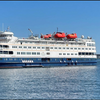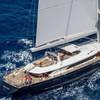Against the backdrop of encouraging global economic growth and an improved outlook for the shipping industry, the International Union of Marine Insurance (IUMI) gives expert opinion on the current state of the hull, cargo and offshore energy insurance markets at its Spring Conference in Hamburg.
The past three years has seen the frequency of total losses within the global fleet stabilise at 0.13% by number (0.05% by tonnage). This is largely attributable to an improved safety climate, improvements in naval architecture and marine engineering; and more effective regulation.
Total losses involving vessels younger than 15 years were significantly less during the 2013-17 period than the years 2008-2012. The frequency of serious casualties* has increased since 2014 but appeared to be stable in 2016-17.
Concerns within the hull insurance market remain, however: “All hull markets acknowledge the severe volatility inherent in a typical international hull portfolio,” says Mark Edmondson, Chair of IUMI’s Ocean Hull Committee. “The global premium base has been eroding year-on-year as a result of reduced asset values, reduced activity in some sectors, and reduced premium rates. Although the financial impact of major casualties was modest recently, increasing values of single risks bear the potential risk of new record losses, and attritional losses are a growing concern.”
Alongside risks inherent in operating ever larger vessels, IUMI is also concerned about advances in the digital applications involved with naval architecture and the operation of vessels – particularly crew training and their ability to manage cutting edge technology and large amounts of data. IUMI is seeing evidence that the frequency of collisions is increasing, possibly resulting from the introduction of modern technology.
The marine cargo insurance market is improving and stabilising but remains highly competitive with an abundance of capacity.
Amongst the many challenges facing the line are larger and more complex risks, natural catastrophes (NAT CAT), vessel and port accumulations and larger outlier losses. The sector is facing a commoditisation of speciality lines, an increase in broker facilities with high commissions and rising expense ratios. Additionally, underwriters must comply with sanctions and requirements for globally compliant programmes including locally admitted policies where required.
2017 saw the worst NAT CAT losses in history for the property and casualty (P&C) insurance sector – these were caused by hurricanes Harvey, Irma, Nate and Maria, the earthquake in Mexico, monsoons in Bangladesh, storms in Durban and wildfires in California.
A 25% increase in the oil price has encouraged an upturn in offshore exploration activity which is starting to impact positively on the offshore energy insurance sector. Similarly, the oil price rally has increased the value of “loss of production” insurance purchased.
Loss activity offshore remains low. Hurricane Harvey bypassed the heavily populated Gulf of Mexico and large losses, in general, were minimal. A worrying trend for construction sector losses involving buoyancy devices seems to be developing, however.
Attritional losses continued to track at a low rate due to reduced activity and improved health and safety practices. But this might reverse as rigs are reactivated.











